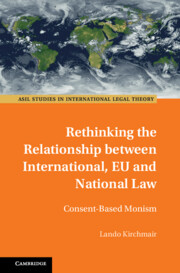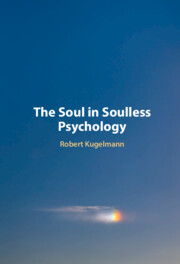74 results
5 - Misrepresenting SAC as Dualism
- from Part II - Structure
-
- Book:
- Morphogenesis Answers Its Critics
- Published online:
- 28 March 2024
- Print publication:
- 04 April 2024, pp 101-121
-
- Chapter
- Export citation
1 - Dualism and Kelsenian Monism
- from Part I - Common Theories on the Relationship of Legal Orders and Their Flaws Concerning the EU Legal Order
-
- Book:
- Rethinking the Relationship between International, EU and National Law
- Published online:
- 29 February 2024
- Print publication:
- 14 March 2024, pp 11-58
-
- Chapter
- Export citation
3 - The “Autonomy” of the EU Legal Order as a Self-Standing Theory?
- from Part I - Common Theories on the Relationship of Legal Orders and Their Flaws Concerning the EU Legal Order
-
- Book:
- Rethinking the Relationship between International, EU and National Law
- Published online:
- 29 February 2024
- Print publication:
- 14 March 2024, pp 95-110
-
- Chapter
- Export citation

Rethinking the Relationship between International, EU and National Law
- Consent-Based Monism
-
- Published online:
- 29 February 2024
- Print publication:
- 14 March 2024

Non-physicalist Theories of Consciousness
-
- Published online:
- 20 December 2023
- Print publication:
- 01 February 2024
-
- Element
-
- You have access
- Open access
- HTML
- Export citation
Do We Look Material? Human Ontology and Perceptual Evidence
-
- Journal:
- Canadian Journal of Philosophy / Volume 53 / Issue 2 / February 2023
- Published online by Cambridge University Press:
- 13 December 2023, pp. 172-186
-
- Article
-
- You have access
- Open access
- HTML
- Export citation
5 - Consenting to International Law in Five Moves
- from Part I - Notions and Roles of Consent
-
-
- Book:
- Consenting to International Law
- Published online:
- 23 November 2023
- Print publication:
- 07 December 2023, pp 117-134
-
- Chapter
- Export citation
11 - Conclusion
- from Part III - Meaningful and Meaningless Waged Work
-
- Book:
- The Politics of Working Life and Meaningful Waged Work
- Published online:
- 02 November 2023
- Print publication:
- 16 November 2023, pp 288-300
-
- Chapter
- Export citation
16 - Domestic Courts and Their Relationship with International Law
- from Part III - The Surroundings of International Law
-
- Book:
- International Law
- Published online:
- 19 October 2023
- Print publication:
- 02 November 2023, pp 317-334
-
- Chapter
- Export citation
You could be immaterial (or not)
-
- Journal:
- Religious Studies , First View
- Published online by Cambridge University Press:
- 09 August 2023, pp. 1-18
-
- Article
- Export citation
Consubstantial dualism: a Zoroastrian perspective on the soul
-
- Journal:
- Religious Studies / Volume 60 / Issue S1 / May 2024
- Published online by Cambridge University Press:
- 02 August 2023, pp. S60-S73
- Print publication:
- May 2024
-
- Article
-
- You have access
- Open access
- HTML
- Export citation
The hard problem of ‘pure’ consciousness: Sāṃkhya dualist ontology
-
- Journal:
- Religious Studies / Volume 60 / Issue S1 / May 2024
- Published online by Cambridge University Press:
- 26 May 2023, pp. S4-S20
- Print publication:
- May 2024
-
- Article
-
- You have access
- Open access
- HTML
- Export citation
4 - International law and Australian law
-
-
- Book:
- Public International Law
- Published online:
- 09 May 2023
- Print publication:
- 23 May 2023, pp 83-106
-
- Chapter
- Export citation
10 - Treaties and Domestic Law
-
- Book:
- Aust's Modern Treaty Law and Practice
- Published online:
- 13 April 2023
- Print publication:
- 06 April 2023, pp 187-206
-
- Chapter
- Export citation
9 - Soul as a Psychological Category
-
- Book:
- The Soul in Soulless Psychology
- Published online:
- 10 February 2023
- Print publication:
- 16 February 2023, pp 232-276
-
- Chapter
- Export citation
4 - Dissenters II
-
- Book:
- The Soul in Soulless Psychology
- Published online:
- 10 February 2023
- Print publication:
- 16 February 2023, pp 82-114
-
- Chapter
- Export citation
T. F. Torrance, Catholicism, and the quest for church unity
-
- Journal:
- Scottish Journal of Theology / Volume 76 / Issue 3 / August 2023
- Published online by Cambridge University Press:
- 15 February 2023, pp. 256-268
- Print publication:
- August 2023
-
- Article
- Export citation

The Soul in Soulless Psychology
-
- Published online:
- 10 February 2023
- Print publication:
- 16 February 2023
1 - What Is International Law?
-
- Book:
- Fundamental Perspectives on International Law
- Published online:
- 23 November 2022
- Print publication:
- 15 December 2022, pp 16-52
-
- Chapter
- Export citation
Chapter 19 - Mr. Consciousness
- from Part II - Ideas
-
-
- Book:
- David Foster Wallace in Context
- Published online:
- 18 November 2022
- Print publication:
- 01 December 2022, pp 203-212
-
- Chapter
- Export citation



